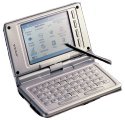Virtual platform speeds i.MX31 phone development
June 15, 2005Virtio is shipping virtual platform technology for Freescale's newest mobile multimedia processor. The VPMX31 Virtual Platform aims to enable parallel software and hardware development efforts for devices based on i.MX31/i.MX31L chips, including mobile phones and handheld wireless entertainment devices. (more…)
 Taiwanese pager maker Unication demonstrated a Linux-based PDA at Computex last week. The Magpie offers unique and sophisticated features, including an integrated FM transmitter, WiFi, and full Opera browser. However, the device has a low-quality plastic case reminiscent of handheld gaming devices,
Taiwanese pager maker Unication demonstrated a Linux-based PDA at Computex last week. The Magpie offers unique and sophisticated features, including an integrated FM transmitter, WiFi, and full Opera browser. However, the device has a low-quality plastic case reminiscent of handheld gaming devices,  [Updated 3PM] — TimeSys has secured $6M in a round of funding led by Adams Capital Management, with participation from Philips Electronics, The Hillman Company, and CEO Larry Weidman (pictured). TimeSys will use the money to expand commercial reach. Additionally, the company has hired Michel Genard
[Updated 3PM] — TimeSys has secured $6M in a round of funding led by Adams Capital Management, with participation from Philips Electronics, The Hillman Company, and CEO Larry Weidman (pictured). TimeSys will use the money to expand commercial reach. Additionally, the company has hired Michel Genard  VersaLogic is shipping a low-power PC/104-Plus single-board computer (SBC) based on an AMD Elan SC520 system-on-chip (SoC) processor. The Lynx SBC supports Linux, and is aimed at headless (no monitor, keyboard, or mouse) embedded applications in monitoring, control, and communications equipment.
VersaLogic is shipping a low-power PC/104-Plus single-board computer (SBC) based on an AMD Elan SC520 system-on-chip (SoC) processor. The Lynx SBC supports Linux, and is aimed at headless (no monitor, keyboard, or mouse) embedded applications in monitoring, control, and communications equipment.  Kontron has published the specifications for a “computer-on-module” (COM) form-factor that it hopes to establish as an industry-wide standard for RISC-based embedded systems. The “E2Brain” spec is available for free public download, and Kontron is forming a consortium to promote the spec.
Kontron has published the specifications for a “computer-on-module” (COM) form-factor that it hopes to establish as an industry-wide standard for RISC-based embedded systems. The “E2Brain” spec is available for free public download, and Kontron is forming a consortium to promote the spec.  The annual Smartphone Summit returns to San Francisco this Fall, with a one-day “Smartphone Summit” for developers followed by a two-day “Enterprise Mobility Pavillion” for users and IT professionals. The developer Summit includes sessions on smartphone applications and operating systems, including embedded Linux.
The annual Smartphone Summit returns to San Francisco this Fall, with a one-day “Smartphone Summit” for developers followed by a two-day “Enterprise Mobility Pavillion” for users and IT professionals. The developer Summit includes sessions on smartphone applications and operating systems, including embedded Linux.  Fluffy Spider Technologies (FST) has added embedded Linux and Qtopia support to its lightweight special effects software for user interfaces (UIs). FST FancyPants supports skinning, overlays, and fancy effects, and targets media-centric consumer and mobile devices, such as POS (point-of-sales/service) systems, set-top boxes, and mobile phones.
Fluffy Spider Technologies (FST) has added embedded Linux and Qtopia support to its lightweight special effects software for user interfaces (UIs). FST FancyPants supports skinning, overlays, and fancy effects, and targets media-centric consumer and mobile devices, such as POS (point-of-sales/service) systems, set-top boxes, and mobile phones.  Sony will position its next-generation gaming console as an “entertainment supercomputer” that can edit videos, manipulate photos, and more, thanks to interchangeable hard drives pre-installed with task-based Linux operating systems of various kinds, according to a Gamespot translation of an interview in a Japanese-language technical magazine.
Sony will position its next-generation gaming console as an “entertainment supercomputer” that can edit videos, manipulate photos, and more, thanks to interchangeable hard drives pre-installed with task-based Linux operating systems of various kinds, according to a Gamespot translation of an interview in a Japanese-language technical magazine.  [Updated 4PM] — Digital Techniques used Linux, off-the-shelf mini-ITX parts, and high-end PCI sound cards to build a line of digital home music servers. The Blackbird servers have 80-300GB hard drives, lots of networking options, and a web interface supporting control from a wireless PDA.
[Updated 4PM] — Digital Techniques used Linux, off-the-shelf mini-ITX parts, and high-end PCI sound cards to build a line of digital home music servers. The Blackbird servers have 80-300GB hard drives, lots of networking options, and a web interface supporting control from a wireless PDA.